Policy Reports
Think New Mexico produces one major policy report a year. These reports are summarized here, and most are available for download as pdf documents. If you are interested in ordering a printed version of any of these policy reports, please complete our order form.
 How to Solve New Mexico’s Health Care Worker Shortage (2024) How to Solve New Mexico’s Health Care Worker Shortage (2024)Download Report Order a Copy of this Report Think New Mexico’s latest policy report proposes a ten-point plan with 20 separate legislative recommendations to address the urgent crisis of New Mexico’s health care worker shortage. The report begins by detailing the growing shortage, such as the loss of 30% of New Mexico’s primary care physicians from 2017-2021. It traces the history of this shortage, and then presents ten major reforms that would reverse the loss of health care professionals and make the state a better place to practice medicine. The reforms include: reforming the state’s medical malpractice act to restore balance while still protecting patients; joining all ten major interstate medical compacts; creating a centralized credentialing system to reduce administrative burdens on health care professionals; making New Mexico’s student loan repayment program for health care professionals more competitive with other states; making New Mexico’s tax policy friendlier to health care professionals; enhancing Medicaid reimbursement rates and reducing Medicaid claim denials; growing more of our own health care workers by expanding access to health-care-related career and technical education (CTE) in high school by providing liability protections to employers that offer CTE programs and ensuring that more students earn health care certifications in high school; expanding access to higher education in health care fields by increasing salaries for the faculty training future health care professionals and providing a tax credit for preceptors; bringing more internationally trained doctors to the state; and investing some of the state’s one-time budget surplus in a $2 billion permanent fund for health care to fund these and other reforms over the long term. |
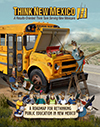 A Roadmap for Rethinking Public Education in New Mexico (2022) A Roadmap for Rethinking Public Education in New Mexico (2022)Download Report Order a Copy of this Report Think New Mexico’s latest policy report presents a sweeping ten point plan with 30 separate legislative recommendations to improve the performance of New Mexico’s struggling public education system, which placed last in the nation for quality by five separate rankings in the last year. The report begins by highlighting the recent educational progress made by students in Mississippi, which has long ranked at or near the bottom of the nation alongside New Mexico. After instituting a series of reforms, Mississippi students leapfrogged ahead of those from many other states on national reading and math tests, demonstrating that a relatively poor state with many challenges can dramatically improve student outcomes. The report then lays out detailed evidence in support of each of its of education reform proposals, which are organized under ten overarching ideas, including optimizing time for teaching and learning; improving teacher training; revamping the state’s colleges of education; enhancing principal pay and training; upgrading the quality of local school boards; right-sizing to smaller districts, schools, and classes; maximizing the benefits of charter schools; providing a relevant and rigorous curriculum; depoliticizing student assessments; and maximizing the amount of the education budget that is spent in the classroom, rather than on school district central administration. Every reform presented in the report is backed by evidence showing that it can significantly move the needle for student achievement, based on experience in New Mexico and elsewhere. |
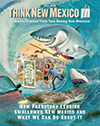 How Predatory Lending Swallowed New Mexico and What We Can Do About It (2020) Download Report Order a Copy of this Report How Predatory Lending Swallowed New Mexico and What We Can Do About It (2020) Download Report Order a Copy of this ReportThis policy report begins by illustrating the state’s predatory lending crisis. It profiles a typical borrower, a low-income working New Mexican, and a typical lender, an out-of-state corporation that charges the highest interest rates permitted by state law. In New Mexico, that is 175% per year. The report then traces the history of predatory lending in the state, highlighting the fact that New Mexico, along with many other states, capped the annual interest rates on small loans at 36% between the 1950s and early 1980s. This interest rate cap worked well until an accident of history intervened. High inflation during the late 1970s and early 1980s drove up national interest rates, and in 1981, the New Mexico legislature repealed the interest rate cap. In the following years, predatory lenders flooded into New Mexico, with the number of small loan stores growing by over 1,400% during the 1990s. In 2017, New Mexico reinstated an interest rate cap, but at a very high level: 175% per year. The report proposes that New Mexico lower that cap to 36%, following in the footsteps of a growing number of other states and the federal Military Lending Act, which caps the cost of credit provided to military families at 36%. The report addresses three misconceptions about this reform: first, it details the many alternative sources of affordable credit available to residents in states with 36% interest rate caps, including credit unions, Community Development Financial Institutions, and employer-based loans; second, it demonstrates that legitimate small loan lenders can and do continue to operate in states with 36% caps; and third, it show that imposing a 36% cap does not lead to more people taking out loans from unscrupulous online loan sharks. Finally, the report recommends making a course in financial literacy a high school graduation requirement and adding it to the state’s education standards, similar to the requirements in in twenty-one other states, including several of New Mexico’s neighbors. |
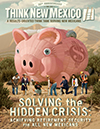 Solving the Hidden Crisis: Achieving Retirement Security for All New Mexicans (2019) Download Report Order a Copy of this Report Solving the Hidden Crisis: Achieving Retirement Security for All New Mexicans (2019) Download Report Order a Copy of this ReportThis policy report begins by outlining the state’s looming retirement security crisis. New Mexico ranks third highest in the nation for the percentage of seniors living in poverty (12.2%), and 80% of the state’s private sector workers have less than $10,000 saved for retirement. Meanwhile, the state’s public pensions are underfunded by a total of $12.5 billion. To address this retirement security crisis, the report recommends three major reforms. First, the report propose that policymakers repeal the state’s income tax on Social Security benefits. The report tells the story of how, back in 1990, a single line in a long and complex tax bill made New Mexico one of only 13 states to tax Social Security benefits. Second, the report describes an innovative reform that would ensure that every private sector worker in New Mexico has access to a retirement account that they can contribute to using automatic payroll deductions. The report cites research showing that workers are 15 times more likely to save for retirement if they can contribute to a retirement plan using automatic payroll deductions. Finally, the report lays out three recommendations to improve the stability and performance of New Mexico’s public pension funds: use some of the state’s record budget surplus to make a one-time, $700 million cash infusion or bridge loan to the Public Employees Retirement Association (PERA); consolidate the investment management of PERA and Education Retirement Board (ERB) pension funds to achieve higher returns and lower fees; and (3) professionalize the pension oversight boards by increasing the qualifications of those who serve on them (currently, no member of the PERA board, which oversees $15.7 billion, is required to have any experience or expertise in financial or investment management). |
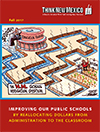 Improving Our Public Schools by Reallocating Dollars from Administration to the Classroom (2017) Download Report Order a Copy of this Report Improving Our Public Schools by Reallocating Dollars from Administration to the Classroom (2017) Download Report Order a Copy of this ReportIn this policy report, Think New Mexico sets out to solve the riddle of why New Mexico’s student outcomes have remained stuck at the bottom of the nation even as our education spending has increased. The report begins by highlighting several outperforming school districts in New Mexico, from Texico to Gadsden, many of which are located in communities whose median family income is below the state average. Along with achieving high graduation rates and math and reading scores, these districts spend a larger percentage of their budgets in the classroom, rather than on administration. The report discusses the research indicating that student performance is much more strongly correlated with dollars spent on instruction than it is with total spending per student. Statewide, only about 57.2% of New Mexico’s education budget is currently dedicated to instruction. The report notes that, since about 90% of New Mexico’s operational education budget consists of state taxpayer dollars, the legislature and governor have the responsibility to ensure that the money is spent as effectively as possible. The report recommends that the state establish minimum percentages of each school district’s budget that must be spent in the classroom, based on the size of the district. The report goes on to make specific recommendations of administrative savings, such as reducing unnecessary reporting burdens, cutting specific administrative costs, eliminating spending on public relations and hired lobbyists, and right-sizing underperforming districts. The recommendations would save more than $100 million, and the report concludes by highlighting evidence-based programs where those dollars could be invested, from prekindergarten and K-3 Plus to higher salaries for teachers and principals. |
 The Story of the Christmas Tree Bill: Fixing Public Infrastructure Spending in New Mexico (2015) Download Report Order a Copy of this Report The Story of the Christmas Tree Bill: Fixing Public Infrastructure Spending in New Mexico (2015) Download Report Order a Copy of this ReportThis policy report begins by describing the state’s public infrastructure crisis, from leaking dams to crumbling roads to half-finished public buildings. It explains that a major cause of this crisis is New Mexico’s dysfunctional system for funding public infrastructure. The report traces the history of that system to the creation of the annual “Christmas Tree Bill” in 1977. This bill allows each individual legislator to select projects for their district, without any statewide prioritization or planning. The report then details the specific problems that result from this process, including the politicization of the process and the way that a lack of transparency favors the interests of lobbyists for special interests over the public. In addition, urgent priorities tend to be neglected or underfunded while hundreds of smaller, less urgent projects are funded. This underfunding of large projects means that millions of dollars sit idle while state agencies and local governments try to scrape together the rest of the funding. The report then contrasts New Mexico’s system with models of infrastructure funding in other states, including Oklahoma and Utah, and highlights examples where the New Mexico legislature and governor have improved the process for funding certain types of infrastructure, including public school buildings, water projects, tribal infrastructure, and colonias infrastructure. Finally, the report lays out a detailed proposal for replacing New Mexico’s Christmas Tree Bill with a transparent, merit-based process. That process includes the creation of an independent Capital Outlay Planning Board to guide the prioritization of the state’s infrastructure needs and ensure that they are fully funded. |
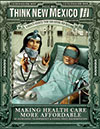 Making Health Care More Affordable By Increasing Transparency and Ending Price Discrimination (2014) Download Report Order a Copy of this Report Making Health Care More Affordable By Increasing Transparency and Ending Price Discrimination (2014) Download Report Order a Copy of this ReportThink New Mexico’s 2014 policy report describes how the development of the health care and insurance system over the last century divorced patients from the cost of their medical care. This history has contributed to the soaring cost of health care and has made it impossible for New Mexicans to shop around for the most affordable, highest quality care. To address this problem, the report recommends two major reforms. First, health care prices and relevant, risk-adjusted quality metrics should be disclosed on a user-friendly public website, similar to those in fourteen other states. Second, the report proposes ending price discrimination by requiring hospitals to charge the same price to every patient for the same procedure, regardless of who is paying the bills. The report describes how these reforms have been recommended by health care economists and other experts for many years and how similar reforms have helped limit the growth of health care prices in other states. Finally, the report explains how stakeholders including patients, doctors, hospitals, insurance companies, and state taxpayers can all benefit from the proposed reforms. For example, by reducing unnecessary administrative costs, the reforms would result in cost savings of about $1.7 billion annually, or $868 per New Mexican per year. |
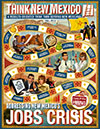 Addressing New Mexico’s Jobs Crisis (2013) Download Report Order a Copy of this Report Addressing New Mexico’s Jobs Crisis (2013) Download Report Order a Copy of this ReportThis policy report begins by describing how New Mexico is lagging behind the rest of the nation in recovering from the 2008 Great Recession and how the historical development of the state’s economy has contributed to the crisis. It then recommends three specific reforms. First, attract more entrepreneurs to the state by offering in-state tuition to international STEM (science, technology, engineering, and math) and Business students at New Mexico’s public universities. Statistically, these students are most likely to start new companies and create jobs for New Mexicans. Second, reduce administrative burdens on businesses by creating a one-stop business portal for all fees and filings, similar to those in 18 other states. Finally, establish a post-performance incentive that offers businesses a rebate of up to 30% of the new tax revenue they produce when they relocate to or expand operations in New Mexico—but only after new jobs and new state revenues have been created. The report concludes by identifying seven special interest tax loopholes that could be closed in order to pay for the proposed reforms. |
 Rethinking the PRC (2011) Download Report Order a Copy of this Report Rethinking the PRC (2011) Download Report Order a Copy of this ReportThink New Mexico’s 2011 policy report explains how the state’s Public Regulation Commission (PRC) can be fundamentally reformed by reducing its jurisdiction and increasing commissioner qualifications. The report begins with the story of how the PRC was created almost by accident in the late 1990s, and then traces the history of regulation in New Mexico back to statehood, illustrating how the state’s regulatory agencies resulted more from politics than from any rational design. The PRC now has the broadest jurisdiction of any state utility regulatory agency in the nation, and PRC commissioners tend to be less qualified than their peers in other states. To reform the PRC, the report recommends decentralizing the PRC’s jurisdiction and improving PRC commissioner qualifications by requiring candidates to have either a four-year degree from an accredited college or five years of relevant professional experience. Finally, the report documents how these reforms would not only improve utility regulation in New Mexico, but would also save taxpayer dollars. |
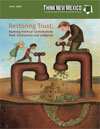 Restoring Trust: Banning Political Contributions from Contractors and Lobbyists (2009) Download Report Order a Copy of this Report Restoring Trust: Banning Political Contributions from Contractors and Lobbyists (2009) Download Report Order a Copy of this ReportThis policy report recommends prohibiting government contractors, anyone seeking major government subsidies, and registered lobbyists from making or bundling political contributions to state or local elected officials. The report begins by describing New Mexico’s long struggle against political corruption, dating back to well before statehood, and notes that the common denominator in many of the state’s most recent scandals is government contractors and lobbyists making political contributions to the elected officials who can award them public dollars. In 2007, New Mexico’s Legislature and Governor took an important first step toward addressing this problem when they enacted the Gift Act by a strong bipartisan majority. The Gift Act prohibits state contractors, seekers of major government subsidies, and registered lobbyists from making gifts worth more than $250 to state candidates or public officials. The report proposes building on these reforms by extending the prohibition to include political contributions as well as gifts. The report concludes by describing how these reforms have helped change the political culture in the seven states where they have been enacted and how they could strengthen the voices of everyday New Mexicans. |
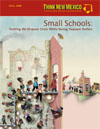 Small Schools: Tackling the Dropout Crisis While Saving Taxpayer Dollars (2008) Download Report Order a Copy of this Report Small Schools: Tackling the Dropout Crisis While Saving Taxpayer Dollars (2008) Download Report Order a Copy of this ReportThink New Mexico’s 2008 policy report makes the case for small schools as a strategy to improve New Mexico’s dismal graduation rate and student performance. The report describes the history of how New Mexico’s public education system was transformed from a network of small community schools to large, centralized dropout factories. It then reviews the research demonstrating that small schools have higher graduation rates, higher student achievement, more participation in extracurricular activities, lower levels of student alienation and violence, and higher levels of satisfaction among students, parents, principals, and teachers. The report reveals that the conventional wisdom that large schools are less expensive to build and operate is false; in fact, high schools larger than about 900 students cost more than small high schools due to inefficiencies that result from increases in bureaucracy, security, and transportation. The report highlights successful small schools in New Mexico and concludes with Think New Mexico’s proposal to cap the size of new public schools built in the state and implement smaller learning communities in existing large schools. |
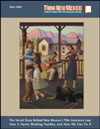 The Secret Story Behind New Mexico’s Title Insurance Law, How it Harms Working Families, and How We Can Fix It (2007) Download Report Order a Copy of this Report The Secret Story Behind New Mexico’s Title Insurance Law, How it Harms Working Families, and How We Can Fix It (2007) Download Report Order a Copy of this ReportThis policy report tells the story of how New Mexico came to have a title insurance law that prohibits free market competition and requires the state Superintendent of Insurance to set a single rate that all title insurance companies must follow. The result of this law is that New Mexico’s working families face the eighth highest closing costs in the nation, a serious obstacle to homeownership. The report outlines a three step solution for reforming title insurance in the state: first, allow the free market, instead of the government, to set the price of title insurance. Second, encourage lenders to leverage their market clout and purchase title insurance policies on behalf of their consumers. Finally, end the title insurers’ immunity from negligence liability. These reforms would save New Mexico homebuyers approximately $40 million annually. |
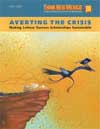 Averting the Crisis: Making Lottery Success Scholarships Sustainable (2006) Download pdf Order a Copy of this Report Averting the Crisis: Making Lottery Success Scholarships Sustainable (2006) Download pdf Order a Copy of this ReportThink New Mexico’s 2006 policy publication proposes the “30% solution” to make Lottery Success Scholarships sustainable: dedicate a minimum of 30% of lottery revenues to the scholarships. In 2006 the scholarships only received 24%, while operating and administrative costs received nearly 20%. The report demonstrates that the cost of running New Mexico’s lottery is very high even when compared to other states that have low populations, rural populations, and low ticket sales. It then provides suggestions for where money can be saved on lottery operating and administrative costs and re-allocated to scholarships, such as re-negotiating the state’s overly expensive online gaming contract with multinational corporation GTech, and reducing the relatively high retailer commissions. The report concludes with a discussion of Minnesota’s recent success in cutting operating and administrative costs while increasing sales and delivering record revenues to the beneficiaries in that state. |
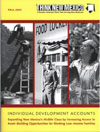 Individual Development Accounts: Expanding New Mexico’s Middle Class by Increasing Access to Asset-Building Opportunities for Working Low-Income Families (2005) Download Report Order a Copy of this Report Individual Development Accounts: Expanding New Mexico’s Middle Class by Increasing Access to Asset-Building Opportunities for Working Low-Income Families (2005) Download Report Order a Copy of this ReportIn this policy report, Think New Mexico describes a strategy for increasing New Mexicans’ access to Individual Development Accounts (IDAs), interest-bearing bank savings accounts where every deposit is matched with state and private dollars. In order to receive the matching funds, IDA account holders attend financial literacy classes, where they learn the basics of how to save, invest, budget, reduce debt, and manage their finances for the long-term. The report describes the success of IDAs in other states, and proposes a strategy for expanding access to IDAs in New Mexico that builds on the existing network of nonprofits, small business development centers, and financial institutions. The report also includes a plan to pay for the IDAs by reducing the operating costs of the state lottery, currently among the highest in the nation on a percentage basis. |
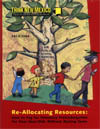 Re-Allocating Resources: How to Pay for Voluntary Prekindergarten for Four-Year-Olds Without Raising Taxes (2004) Download Report Order a Copy of this Report Re-Allocating Resources: How to Pay for Voluntary Prekindergarten for Four-Year-Olds Without Raising Taxes (2004) Download Report Order a Copy of this ReportThis policy report lays out a strategy for funding prekindergarten by cutting administrative costs in the education system. The report begins by describing the many benefits prekindergarten would provide to New Mexico’s children. It then details a plan to pay for the classes based on the fact that only 55.9 cents of every dollar spent on public education in New Mexico are used for “instructional” purposes – the lowest proportion of any state in the nation. Over 44 cents of every dollar are spent on administration and support services. The bulk of the report analyzes New Mexico’s spending on the public schools and describes specific reforms that, if implemented, would result in nearly $96 million of savings – strategies such as utilizing cooperative purchasing, consolidating some administrative functions at the Regional Education Cooperatives, restructuring ineffective districts, and reforming administrative salary structures. Every dollar spent on administration and support services is a dollar that could directly benefit students if spent on prekindergarten instead. |
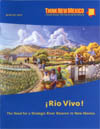 ¡Rio Vivo! The Need for a Strategic River Reserve in New Mexico (2003) Download Report Order a Copy of this Report ¡Rio Vivo! The Need for a Strategic River Reserve in New Mexico (2003) Download Report Order a Copy of this ReportIn its 2003 policy report, Think New Mexico proposes a way to improve the state’s river management policies by creating a Strategic River Reserve, a pool of publicly-held water rights dedicated to protecting and restoring the benefits provided by flowing rivers – including averting lawsuits filed under the Endangered Species Act and Clean Water Act, meeting our interstate river compact obligations, and promoting river-dependent economic development such as boating, fishing, and tourism. The report first describes the challenges faced by New Mexico’s rivers, including drought, population growth, and the competing demands of the federal government, bordering states, and internal conflicts. It then describes how a Strategic River Reserve could be implemented, managed, and funded, and how such a River Reserve would benefit New Mexico’s communities by providing a buffer against both drought and conflict. |
 Why New Mexico Needs to End the Food Tax and How to Do It (2001) Download pdf Order a Copy of this Report Why New Mexico Needs to End the Food Tax and How to Do It (2001) Download pdf Order a Copy of this ReportThink New Mexico’s fourth policy report begins by making the case against the state’s food tax. In 2001, New Mexico was one of only nine states that fully taxed food. The state instituted its tax on food as an emergency measure to increase revenue during the Great Depression. Though that crisis ended over six decades ago, the food tax has more than doubled in the intervening years. It ranges from 5.125% to 7.1875% throughout the state, and costs the average family of four more than $225 each year. The food tax is extremely regressive, as low-income households spend a greater percentage of their income on the food tax than do households from higher income brackets. The food tax is also an anti-family tax: households with more mouths to feed buy more groceries and therefore pay more food tax. The food tax really punishes large families, which tend to be disproportionately Hispanic and Native American in New Mexico, according to Census figures. The report concludes by offering ideas for making the repeal of the food tax revenue neutral, such as by increasing taxes on tobacco and alcohol. |
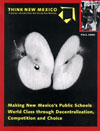 Making New Mexico’s Public Schools World Class through Decentralization, Competition and Choice (2000) Download Report Order a Copy of this Report Making New Mexico’s Public Schools World Class through Decentralization, Competition and Choice (2000) Download Report Order a Copy of this ReportThis publication proposes a “third way” to improving New Mexico’s public schools, a middle path between the extremes of the status quo and vouchers. The report describes Think New Mexico’s proposal for moving more power down to the state’s individual schools by allowing New Mexicans to choose to implement site-based management. Site-based management would allow the principal, parents, and teachers at each school to make decisions about curricula, budgets, and hiring and firing. In tandem with New Mexico’s open enrollment law, this would allow public schools to set their own paths, and students and parents to choose the school that is best for them. |
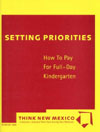 Setting Priorities: How to Pay for Full-Day Kindergarten (1999) Download pdf Order a Copy of this Report Setting Priorities: How to Pay for Full-Day Kindergarten (1999) Download pdf Order a Copy of this ReportThis publication follows the initial proposal for full-day kindergarten by identifying specific ways to pay for it by cutting wasteful government spending. In order to pay the net annual operational cost of full-day kindergarten, estimated at about 1% of the General Fund, the report proposes a variety of cost-saving measures determined through a detailed examination of New Mexico’s General Fund budget. The measures discussed include: cutting non-essential spending in professional service contracts; ending the volume discount on taxes paid by tobacco distributors; abolishing non-essential and duplicative boards and commissions; cutting non-essential spending at the Public Regulation Commission; and ending New Mexico’s Animal Damage Control subsidy. All of these proposals emphasize making public spending decisions that reflect the best interests of all New Mexicans, rather than the special interests of a few. |
 Increasing Student Achievement in New Mexico: The Need for Universal Access to Full-Day Kindergarten (1999) Download pdf Order a Copy of this Report Increasing Student Achievement in New Mexico: The Need for Universal Access to Full-Day Kindergarten (1999) Download pdf Order a Copy of this ReportThink New Mexico’s inaugural publication explains why full-day kindergarten is a vital first step to increasing student achievement in New Mexico. The report first traces the history of kindergarten in New Mexico and attributes the origins of the half-day schedule (a misnomer, since it is only 2 hours and 45 minutes) to an accident of history: World War II. The report also describes the benefits of full-day kindergarten for three key populations: students, parents, and teachers. For example, full-day students outperform their half-day counterparts on learning achievement measures, experience an enriched curriculum, and have a smoother transition into first grade. Teachers are given half as many students with twice the time to teach them. The report concludes with a discussion of the finances of full-day kindergarten, including the savings from reduced transportation costs and reduced Special Education costs. |

